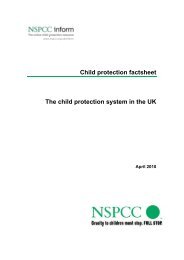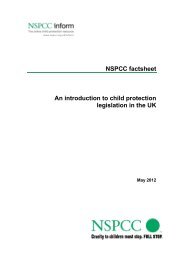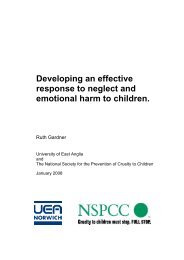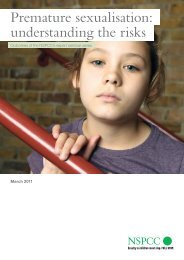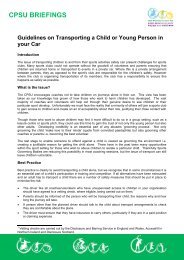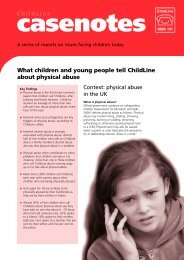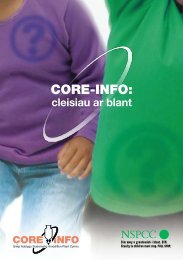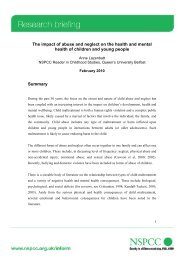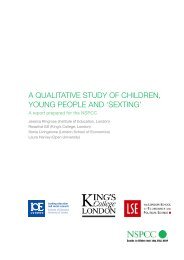Neglect and serious case reviews (PDF, 735KB) - nspcc
Neglect and serious case reviews (PDF, 735KB) - nspcc
Neglect and serious case reviews (PDF, 735KB) - nspcc
Create successful ePaper yourself
Turn your PDF publications into a flip-book with our unique Google optimized e-Paper software.
4<br />
Implications for policy <strong>and</strong><br />
practice<br />
All child protection practice involves managing risk, as the Munro Review of Child<br />
Protection reminds us (Munro 2011). This study does not provide easy answers about<br />
the difficult judgements <strong>and</strong> decisions that need to be made where neglect is present but<br />
shows how important it is to be open minded <strong>and</strong> vigilant about where <strong>and</strong> how neglect<br />
related risks manifest themselves. We have shown here that neglect is much more<br />
prevalent in <strong>serious</strong> <strong>case</strong> <strong>reviews</strong> than had previously been understood. We have tried to<br />
describe the different ways in which neglect can contribute to a catastrophic outcome for<br />
a child <strong>and</strong> how neglect can function to mask, conceal or deflect signs of other danger<br />
to a child. Overall, the study offers a strong message, that in rare circumstances, neglect<br />
can be life threatening <strong>and</strong> needs to be treated with as much urgency as other categories<br />
of maltreatment. Although neglect rarely results in a catastrophic event it very often<br />
leads to developmental damage so vigilance is needed with all <strong>case</strong>s of neglect.<br />
There are a range of interconnecting ways of considering implications for policy<br />
<strong>and</strong> practice. The response to neglect can be understood in relation to the age <strong>and</strong><br />
development of the child; it can also be considered in relation to the kinds of help <strong>and</strong><br />
types of services the child <strong>and</strong> family or young person attract. From whichever angle<br />
the problem of neglect is seen however, there is usually a common thread of severe<br />
difficulties in the relationship between the child <strong>and</strong> their caregivers, <strong>and</strong> the impact of<br />
that relationship on the child over time. However, a child is not necessarily safe even<br />
when there is a good relationship with parents or carers if home conditions leave the<br />
child in danger. For the child to stay safe <strong>and</strong> healthy they also need a safe <strong>and</strong> healthy<br />
environment in which to live.<br />
Underst<strong>and</strong>ing the implications of children’s experiences of neglect in age related<br />
‘ecological niches’ (Finkelhor 2008, Super <strong>and</strong> Harkness 1986, Stein et al 2009) fits<br />
with the ecological transactional approach that we have used for the study <strong>and</strong> offers<br />
a way of examining the developmental vulnerabilities, risks <strong>and</strong> protective factors that<br />
children carry with them <strong>and</strong> also encounter in their environment. The same ecological<br />
approach also underlines the importance of taking account of the way that practitioners<br />
respond to <strong>and</strong> make sense of the children, their parents <strong>and</strong> the family’s circumstances.<br />
The learning from this re-examination of neglect in <strong>serious</strong> <strong>case</strong> <strong>reviews</strong> has illustrated,<br />
in many respects, a life course profile of children.<br />
79




